|
PLearn 0.1
|
|
PLearn 0.1
|
#include <LearnerCommand.h>
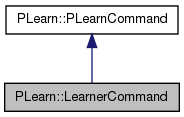
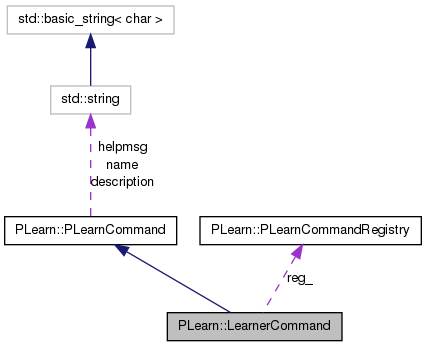
Public Member Functions | |
| LearnerCommand () | |
| virtual void | run (const vector< string > &args) |
| The actual implementation of the 'LearnerCommand' command. | |
Static Public Member Functions | |
| static void | train (const PPath &learner_spec_file, const PPath &trainset_spec, const PPath &save_learner_file, bool no_forget=false) |
| static void | test (const string &trained_learner_file, const string &testset_spec, const string &stats_file, const string &outputs_file, const string &costs_file, const bool set_testset_as_trainingset=false) |
| static void | compute_outputs (const string &trained_learner_file, const string &test_inputs_spec, const string &outputs_file) |
| static void | process_dataset (const string &trained_learner_file, const string &dataset_spec, const string &processed_dataset_pmat) |
| static void | compute_outputs_on_1D_grid (const string &trained_learner_file, const string &grid_outputs_file, real xmin, real xmax, int nx) |
| static void | compute_outputs_on_2D_grid (const string &trained_learner_file, const string &grid_outputs_file, real xmin, real xmax, real ymin, real ymax, int nx, int ny) |
| static void | compute_outputs_on_auto_grid (const string &trained_learner_file, const string &grid_outputs_file, const string &dataset_spec, real extra_percent, int nx, int ny=0) |
| static void | analyze_inputs (const string &data_file, const string &result_file, real epsilon, const TVec< string > &learner_files) |
Static Protected Attributes | |
| static PLearnCommandRegistry | reg_ |
| This allows to register the 'LearnerCommand' command in the command registry. | |
Definition at line 55 of file LearnerCommand.h.
| PLearn::LearnerCommand::LearnerCommand | ( | ) |
Definition at line 59 of file LearnerCommand.cc.
:
PLearnCommand("learner",
"Allows to train, use and test a learner",
"The following forms of the learner command are allowed:\n"
"\n"
"learner train <learner_spec.plearn> <trainset.vmat> <trained_learner.psave> [no_forget]\n"
" - Will train the specified learner on the specified trainset and save the resulting trained learner as\n"
" trained_learner.psave. If the optional keyword argument 'no_forget' is provided, then the learner will\n"
" not be reset by calling forget before training.\n"
"\n"
"learner test <trained_learner.psave> <testset.vmat> <cost.stats> [<outputs.pmat> [<costs.pmat>]] [--set_testset_as_trainingset]\n"
" - Tests the specified learner on the testset. Will produce a cost.stats file (viewable with the plearn stats\n"
" command) and optionally saves individual outputs and costs\n"
"\n"
"learner compute_outputs <trained_learner.psave> <test_inputs.vmat> <outputs.pmat> (or 'learner co' as a shortcut)\n"
"\n"
"learner process_dataset <trained_learner.psave> <dataset.vmat> <processed_dataset.pmat>\n"
" - process a full dataset (possibly containing input,target,weight,extra,parts). \n"
" writes processed dataset as a pmat. This calls method processDataset whose default version \n"
" uses computeOutput to process the input part, and simply passes on the other parts unchanged.\n"
" Typical usage: preprocessing data with PCA for ex. \n\n"
// "learner compute_costs <trained_learner.psave> <testset.vmat> <outputs.pmat> <costs.pmat>\n"
"learner compute_outputs_on_1D_grid <trained_learner.psave> <gridoutputs.pmat> <xmin> <xmax> <nx> (shortcut: learner cg1)\n"
" - Computes output of learner on nx equally spaced points in range [xmin, xmax] and writes the list of (x,output)\n"
" in gridoutputs.pmat \n"
"\n"
"learner compute_outputs_on_2D_grid <trained_learner.psave> <gridoutputs.pmat> <xmin> <xmax> <ymin> <ymax> <nx> <ny> (shortcut: learner cg2)\n"
" - Computes output of learner on the regular 2d grid specified and writes the list of (x,y,output) in gridoutputs.pmat\n"
"\n"
"learner compute_outputs_on_auto_grid <trained_learner.psave> <gridoutputs.pmat> <trainset.vmat> <nx> [<ny>] (shortcut: learner cg)\n"
" - Automatically determines a bounding-box from the trainset (enlarged by 5%), and computes the output along a\n"
" regular 1D grid of <nx> points or a regular 2D grid of <nx>*<ny> points. (Note: you can also invoke command vmat\n"
" bbox to determine the bounding-box by yourself, and then invoke learner cg1 or learner cg2 appropriately)\n"
"\n"
"learner analyze_inputs <data.vmat> <results.pmat> <epsilon> <learner_1> ... <learner_n>\n"
" - Analyze the influence of inputs of given learners. The output of each sample in the data VMatrix is computed\n"
" when each input is perturbed, so as to estimate the derivative of the output with respect to the input. This\n"
" is averaged over all samples and all learners so as to estimate the influence of each input. In the results.pmat\n"
" file, are stored the average, variance, min and max of the derivative for all inputs (and outputs).\n"
"\n"
"The datasets do not need to be .vmat they can be any valid vmatrix (.amat .pmat .dmat)"
)
{}
| void PLearn::LearnerCommand::analyze_inputs | ( | const string & | data_file, |
| const string & | result_file, | ||
| real | epsilon, | ||
| const TVec< string > & | learner_files | ||
| ) | [static] |
Definition at line 274 of file LearnerCommand.cc.
References PLearn::TVec< T >::append(), PLearn::endl(), PLearn::VMat::fieldName(), PLearn::getDataSet(), PLearn::VMat::getExample(), i, j, PLearn::TVec< T >::length(), PLearn::VMat::length(), PLearn::load(), m, PLERROR, PLearn::TVec< T >::subVec(), and w.
Referenced by run().
{
// Load dataset and learners.
cout << "Loading dataset and learners" << endl;
VMat data = getDataSet(data_file);
int dim = data->inputsize();
if (dim <= 0)
PLERROR("In LearnerCommand::analyze_inputs - Cannot analyze inputs if the data's inputsize is not set");
int n_learners = learner_files.length();
TVec< PP<PLearner> > learners(n_learners);
for (int i = 0; i < learner_files.length(); i++)
PLearn::load(learner_files[i], learners[i]);
int n_outputs = learners[0]->outputsize();
// Analyze inputs.
PP<ProgressBar> pb = new ProgressBar("Analyzing inputs", data->length());
Vec v(dim);
Vec w(dim);
Mat outputs(n_learners, n_outputs);
Vec new_output(n_outputs);
Vec dummy_target;
real dummy_weight;
Vec deriv(n_outputs);
TVec<string> stats;
stats.append("E");
stats.append("V");
stats.append("MIN");
stats.append("MAX");
int n_stats = stats.length(); // Number of statistics computed for each input and output.
VMat results = new FileVMatrix(result_file, data->inputsize(), n_stats * n_outputs + 1);
TVec<VecStatsCollector> statscol(dim);
Vec output_k;
for (int i = 0; i < data->length(); pb->update(++i)) {
data->getExample(i, v, dummy_target, dummy_weight);
w << v;
for (int k = 0; k < n_learners; k++) {
output_k = outputs(k);
learners[k]->computeOutput(w, output_k);
}
for (int j = 0; j < dim; j++) {
// Analyze j-th input.
w[j] += epsilon;
for (int k = 0; k < n_learners; k++) {
learners[k]->computeOutput(w, new_output);
// Compute the derivative of the m-th output with respect to the j-th input.
for (int m = 0; m < n_outputs; m++)
deriv[m] = (new_output[m] - outputs(k,m)) / epsilon;
statscol[j].update(deriv);
}
w[j] = v[j];
}
}
// Compiling stats.
pb = new ProgressBar("Compiling statistics", dim);
for (int j = 0; j < dim; pb->update(++j)) {
statscol[j].finalize();
Vec all(1 + n_outputs * n_stats);
for (int i = 0; i < n_stats; i++)
all.subVec(1 + i * n_outputs, n_outputs) << statscol[j].getAllStats(stats[i]);
all[0] = j;
results->putRow(j, all);
results->addStringMapping(0, data->fieldName(j), j);
}
TVec<string> fieldnames;
fieldnames.append("Field");
for (int i = 0; i < n_stats; i++)
for (int j = 0; j < n_outputs; j++)
fieldnames.append(stats[i]);
results->declareFieldNames(fieldnames);
results->saveAllStringMappings();
}
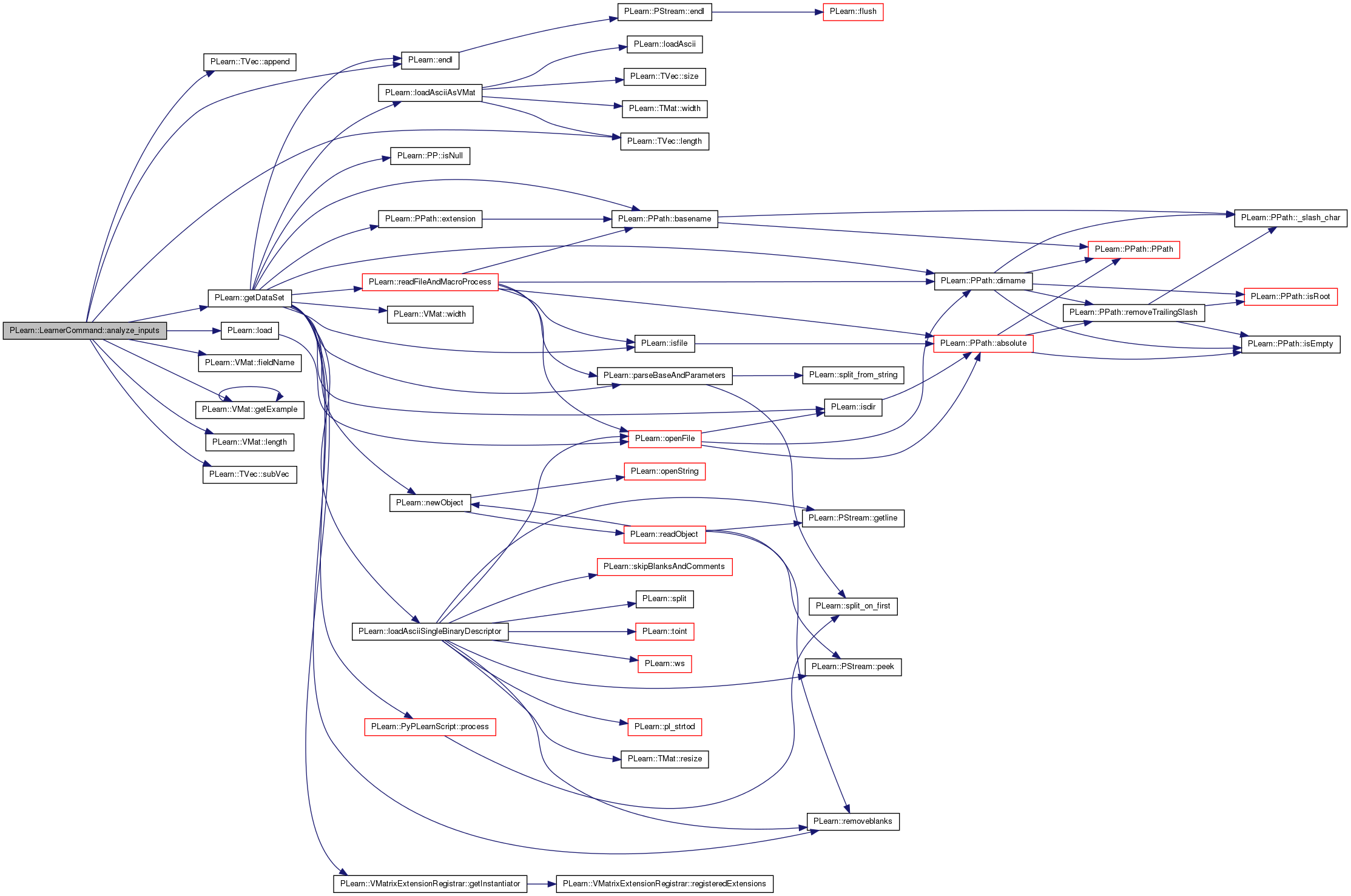

| void PLearn::LearnerCommand::compute_outputs | ( | const string & | trained_learner_file, |
| const string & | test_inputs_spec, | ||
| const string & | outputs_file | ||
| ) | [static] |
Definition at line 160 of file LearnerCommand.cc.
References PLearn::getDataSet(), PLearn::VMat::length(), and PLearn::smartLoadObject().
Referenced by run().
{
PP<PLearner> learner =
(PLearner*) smartLoadObject(trained_learner_file);
VMat testinputs = getDataSet(test_inputs_spec);
int l = testinputs.length();
VMat testoutputs = new FileVMatrix(outputs_file,l,learner->getOutputNames());
learner->use(testinputs,testoutputs);
}
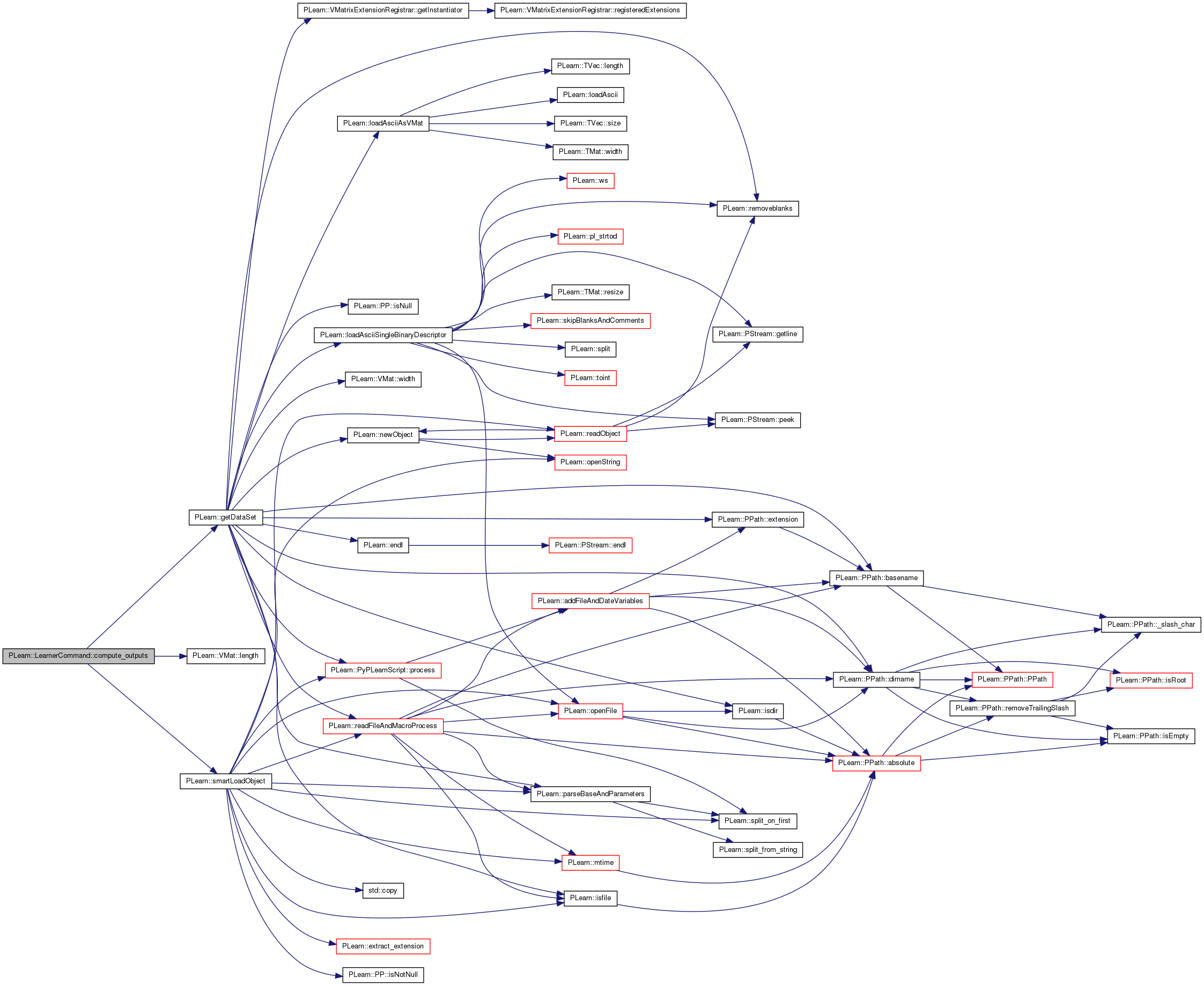

| void PLearn::LearnerCommand::compute_outputs_on_1D_grid | ( | const string & | trained_learner_file, |
| const string & | grid_outputs_file, | ||
| real | xmin, | ||
| real | xmax, | ||
| int | nx | ||
| ) | [static] |
Definition at line 227 of file LearnerCommand.cc.
References i, PLearn::load(), PLERROR, PLearn::TVec< T >::subVec(), and x.
Referenced by compute_outputs_on_auto_grid(), and run().
{
if(nx<2)
PLERROR("In LearnerCommand::compute_outputs_on_1D_grid invalid nx. Must be at least 2");
PP<PLearner> learner;
PLearn::load(trained_learner_file,learner);
if(learner->inputsize()!=1)
PLERROR("In LearnerCommand::compute_outputs_on_1D_grid learner must have inputsize==1 (it's %d)",learner->inputsize());
int outputsize = learner->outputsize();
VMat gridoutputs = new FileVMatrix(grid_outputs_file,0,1+outputsize);
real deltax = (xmax-xmin)/(nx-1);
Vec v(1+outputsize);
Vec input = v.subVec(0,1);
Vec output = v.subVec(1,outputsize);
real x=xmin;
for(int i=0; i<nx; i++, x+=deltax)
{
input[0] = x;
learner->computeOutput(input,output);
gridoutputs->appendRow(v);
}
}
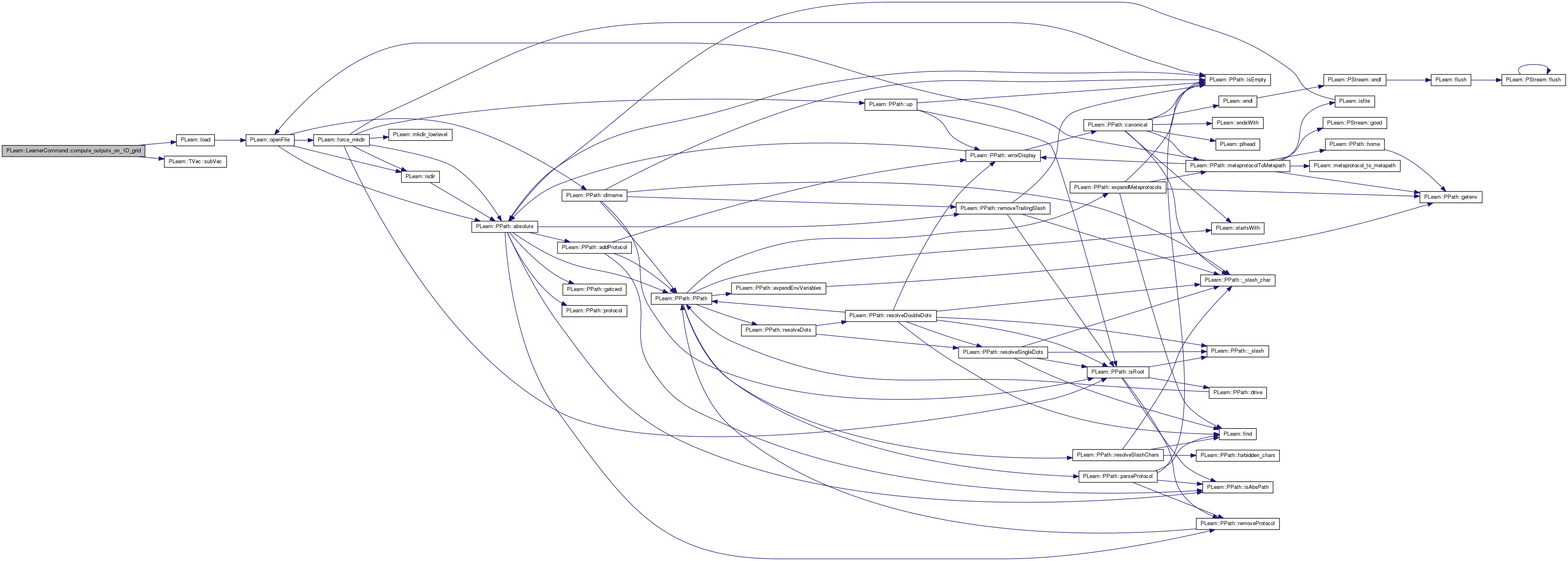

| void PLearn::LearnerCommand::compute_outputs_on_2D_grid | ( | const string & | trained_learner_file, |
| const string & | grid_outputs_file, | ||
| real | xmin, | ||
| real | xmax, | ||
| real | ymin, | ||
| real | ymax, | ||
| int | nx, | ||
| int | ny | ||
| ) | [static] |
Definition at line 185 of file LearnerCommand.cc.
References PLearn::endl(), i, j, PLearn::load(), PLERROR, PLearn::TVec< T >::subVec(), and x.
Referenced by compute_outputs_on_auto_grid(), and run().
{
if(nx<2 || ny<2)
PLERROR("In LearnerCommand::compute_outputs_on_2D_grid invalid nx or ny. Must have at least a 2x2 grid");
PP<PLearner> learner;
PLearn::load(trained_learner_file,learner);
if(learner->inputsize()!=2)
PLERROR("In LearnerCommand::compute_outputs_on_2D_grid learner must have inputsize==2 (it's %d)",learner->inputsize());
int outputsize = learner->outputsize();
VMat gridoutputs = new FileVMatrix(grid_outputs_file,0,2+outputsize);
real deltax = (xmax-xmin)/(nx-1);
real deltay = (ymax-ymin)/(ny-1);
Vec v(2+outputsize);
Vec input = v.subVec(0,2);
Vec output = v.subVec(2,outputsize);
real outputsum = 0;
real x = xmin;
for(int i=0; i<nx; i++, x+=deltax)
{
input[0] = x;
real y = ymin;
for(int j=0; j<ny; j++, y+=deltay)
{
input[1] = y;
learner->computeOutput(input,output);
outputsum += output[0];
gridoutputs->appendRow(v);
}
}
cerr << "integral: " << outputsum*deltax*deltay << endl;
}
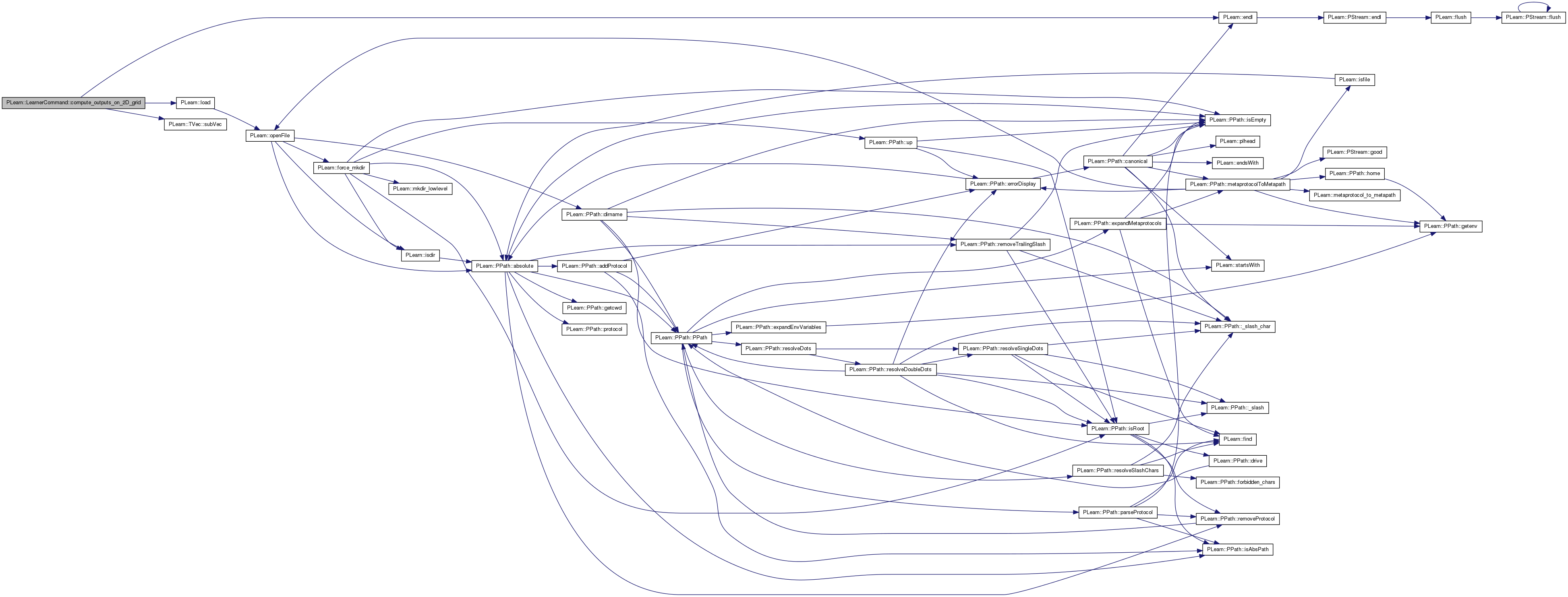

| void PLearn::LearnerCommand::compute_outputs_on_auto_grid | ( | const string & | trained_learner_file, |
| const string & | grid_outputs_file, | ||
| const string & | dataset_spec, | ||
| real | extra_percent, | ||
| int | nx, | ||
| int | ny = 0 |
||
| ) | [static] |
Definition at line 256 of file LearnerCommand.cc.
References compute_outputs_on_1D_grid(), compute_outputs_on_2D_grid(), and PLearn::getDataSet().
Referenced by run().
{
TVec< pair<real,real> > bbox = getDataSet(dataset_spec)->getBoundingBox(extra_percent);
if(ny>0)
compute_outputs_on_2D_grid(trained_learner_file, grid_outputs_file,
bbox[0].first, bbox[0].second, bbox[1].first, bbox[1].second,
nx, ny);
else
compute_outputs_on_1D_grid(trained_learner_file, grid_outputs_file,
bbox[0].first, bbox[0].second,
nx);
}
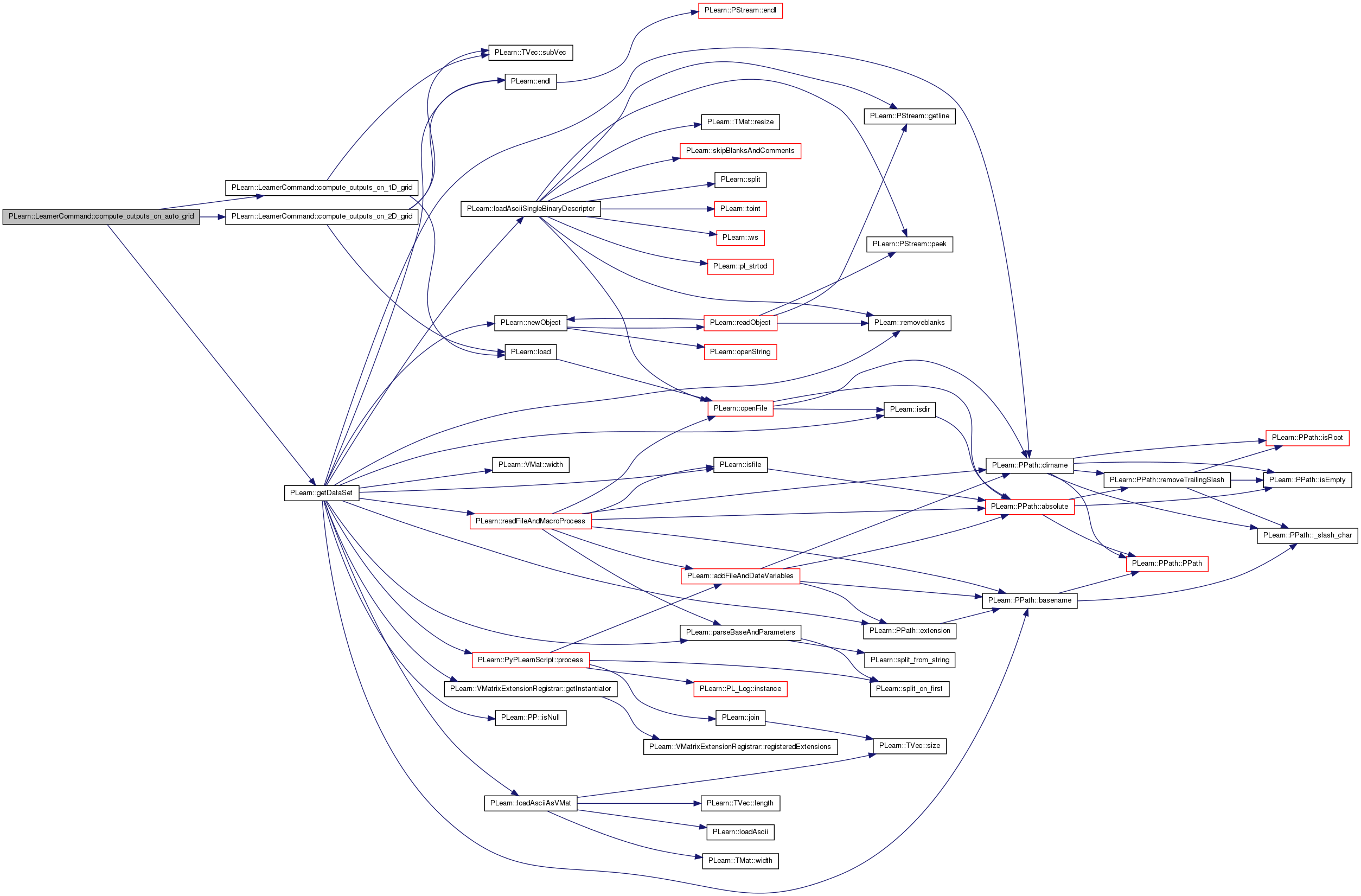

| void PLearn::LearnerCommand::process_dataset | ( | const string & | trained_learner_file, |
| const string & | dataset_spec, | ||
| const string & | processed_dataset_pmat | ||
| ) | [static] |
Definition at line 173 of file LearnerCommand.cc.
References PLearn::getDataSet(), and PLearn::smartLoadObject().
Referenced by run().
{
PP<PLearner> learner =
(PLearner*) smartLoadObject(trained_learner_file);
VMat dataset = getDataSet(dataset_spec);
VMat processed = learner->processDataSet(dataset);
processed->savePMAT(processed_dataset_pmat);
}
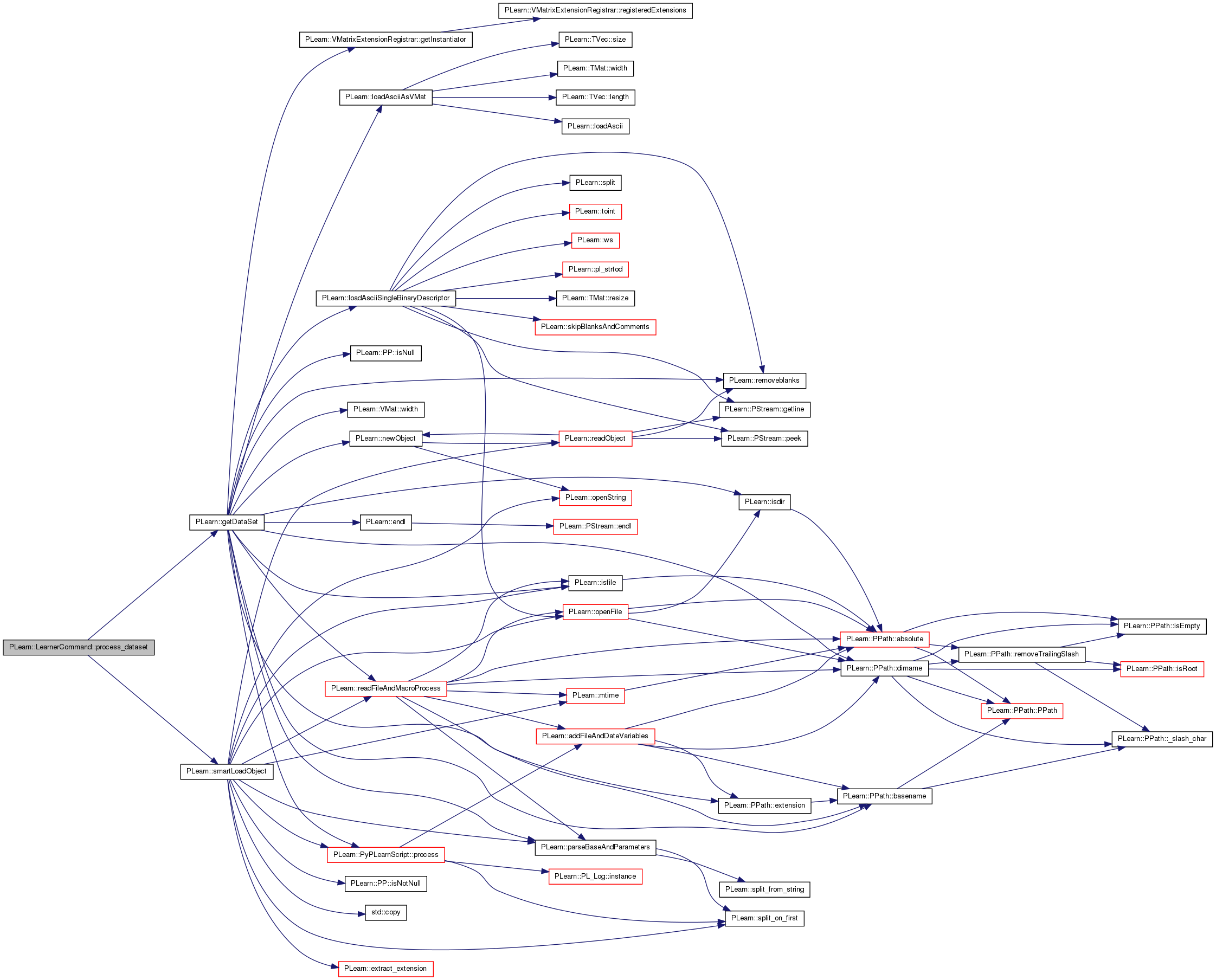

| void PLearn::LearnerCommand::run | ( | const vector< string > & | args | ) | [virtual] |
The actual implementation of the 'LearnerCommand' command.
Implements PLearn::PLearnCommand.
Definition at line 348 of file LearnerCommand.cc.
References analyze_inputs(), PLearn::TVec< T >::append(), compute_outputs(), compute_outputs_on_1D_grid(), compute_outputs_on_2D_grid(), compute_outputs_on_auto_grid(), i, PLearn::pl_isnumber(), PLCHECK, PLERROR, process_dataset(), test(), PLearn::toint(), and train().
{
string command = args[0];
if(command=="train")
{
if (args.size()==4 || args.size() == 5)
train(args[1], args[2], args[3],
args.size() == 5 && args[4] == "no_forget");
else
PLERROR("LearnerCommand::run you must provide 'plearn learner "
"train learner_spec_file trainset_spec save_learner_file "
"[no_forget]'");
}
else if(command=="test")
{
if (args.size()>3)
{
string trained_learner_file = args[1];
string testset_spec = args[2];
string stats_basename = args[3];
string outputs_file;
bool set_testset_as_trainingset = false;
if(args.size()>4){
if(args[4]=="--set_testset_as_trainingset")
set_testset_as_trainingset = true;
else
outputs_file = args[4];
}
string costs_file;
if(args.size()>5){
if(args[5]=="--set_testset_as_trainingset")
set_testset_as_trainingset = true;
else
costs_file = args[5];
}
if(args.size()>6){
PLCHECK(args[6]=="--set_testset_as_trainingset");
set_testset_as_trainingset = true;
}
test(trained_learner_file, testset_spec, stats_basename, outputs_file, costs_file,
set_testset_as_trainingset);
}
else
PLERROR("LearnerCommand::run you must provide at least 'plearn learner test <trained_learner.psave> <testset.vmat> <cost.stats>'");
}
else if ((command=="compute_outputs") ||(command=="co"))
{
if (args.size()==4)
compute_outputs(args[1],args[2],args[3]);
else
PLERROR("LearnerCommand::run you must provide 'plearn learner compute_outputs learner_spec_file trainset_spec save_learner_file'");
}
else if (command=="process_dataset")
{
if (args.size()==4)
process_dataset(args[1],args[2],args[3]);
else
PLERROR("LearnerCommand::run you must provide: plearn learner process_dataset <trained_learner.psave> <dataset.vmat> <processed_dataset.pmat>");
}
else if (command=="compute_outputs_on_1D_grid" || command=="cg1")
{
if(args.size()!=6)
PLERROR("Subcommand learner compute_outputs_on_1D_grid requires 5 arguments. Check the help!");
compute_outputs_on_1D_grid(args[1], args[2], toreal(args[3]), toreal(args[4]), toint(args[5]));
}
else if (command=="compute_outputs_on_2D_grid" || command=="cg2")
{
if(args.size()!=9)
PLERROR("Subcommand learner compute_outputs_on_2D_grid requires 8 arguments. Check the help!");
compute_outputs_on_2D_grid(args[1], args[2],
toreal(args[3]), toreal(args[4]),
toreal(args[5]), toreal(args[6]),
toint(args[7]), toint(args[8]) );
}
else if (command=="compute_outputs_on_auto_grid" || command=="cg")
{
if(args.size()<5)
PLERROR("Subcommand learner compute_outputs_on_auto_grid requires 4 or 5 arguments. Check the help!");
int nx = toint(args[4]);
int ny = 0;
if(args.size()==6)
ny = toint(args[5]);
compute_outputs_on_auto_grid(args[1], args[2],
args[3], 0.05,
nx, ny);
}
else if (command == "analyze_inputs") {
if (args.size() < 5)
PLERROR("In LearnerCommand::run - The 'analyze_inputs' subcommand requires 4 arguments (see help)");
real epsilon;
if (!pl_isnumber(args[3], &epsilon))
PLERROR("In LearnerCommand::run - The 'epsilon' option must be a real number");
TVec<string> learners;
for (size_t i = 4; i < args.size(); i++)
learners.append(args[i]);
analyze_inputs(args[1], args[2], epsilon, learners);
}
else
PLERROR("Invalid command %s check the help for available commands",command.c_str());
}
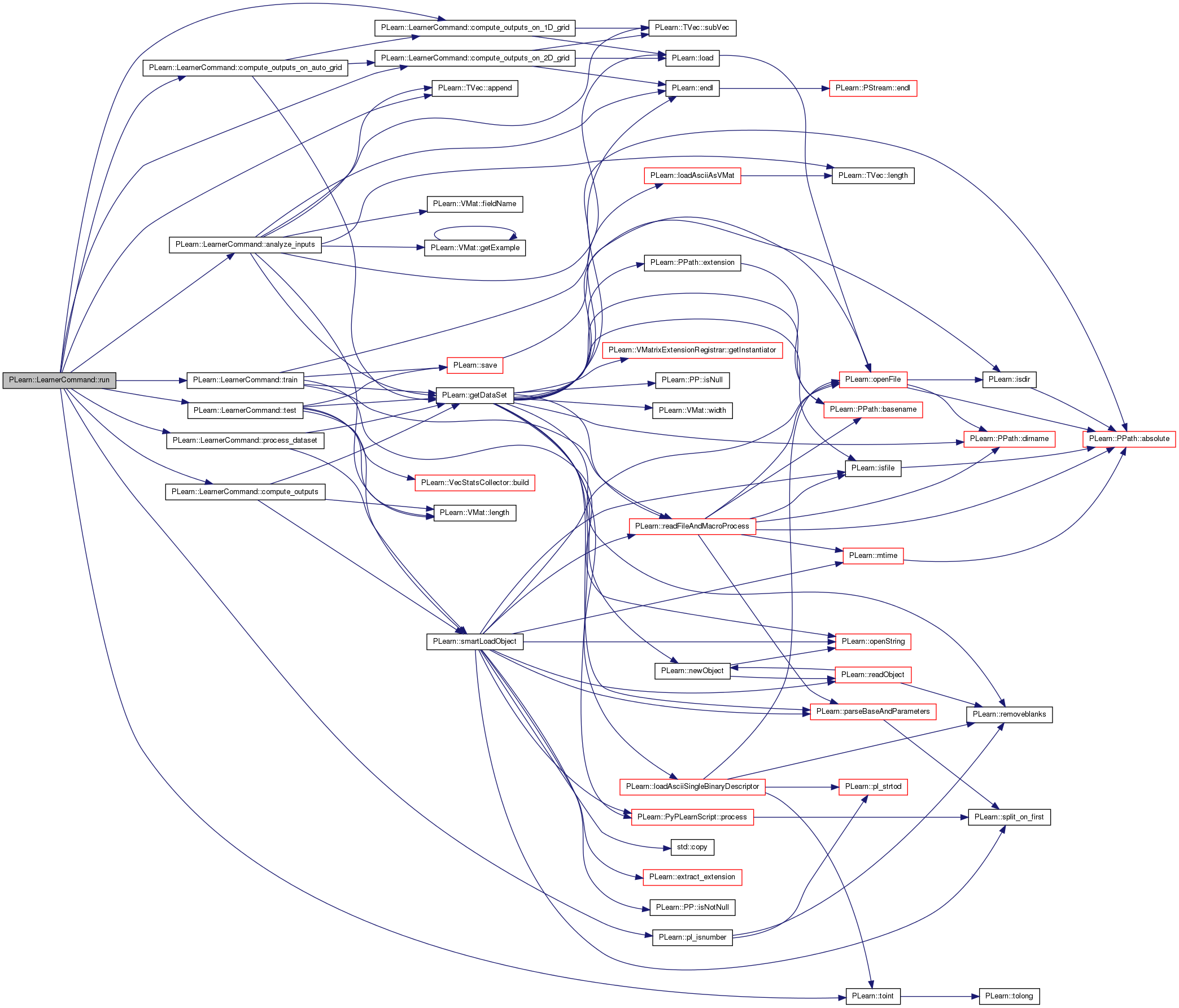
| void PLearn::LearnerCommand::test | ( | const string & | trained_learner_file, |
| const string & | testset_spec, | ||
| const string & | stats_file, | ||
| const string & | outputs_file, | ||
| const string & | costs_file, | ||
| const bool | set_testset_as_trainingset = false |
||
| ) | [static] |
Definition at line 131 of file LearnerCommand.cc.
References PLearn::VecStatsCollector::build(), PLearn::getDataSet(), PLearn::VMat::length(), PLearn::save(), and PLearn::smartLoadObject().
Referenced by run().
{
PP<PLearner> learner =
(PLearner*) smartLoadObject(trained_learner_file);
VMat testset = getDataSet(testset_spec);
int l = testset.length();
VMat testoutputs;
if(outputs_file!="")
testoutputs = new FileVMatrix(outputs_file,l,learner->outputsize());
VMat testcosts;
if(set_testset_as_trainingset){
learner->setTrainingSet(testset, false);
learner->finalize();
}
if(costs_file!="")
testcosts = new FileVMatrix(costs_file,l,learner->getTestCostNames());
PP<VecStatsCollector> test_stats = new VecStatsCollector;
test_stats->build();
test_stats->forget();
learner->test(testset, test_stats, testoutputs, testcosts);
test_stats->finalize();
PLearn::save(stats_file,test_stats);
}
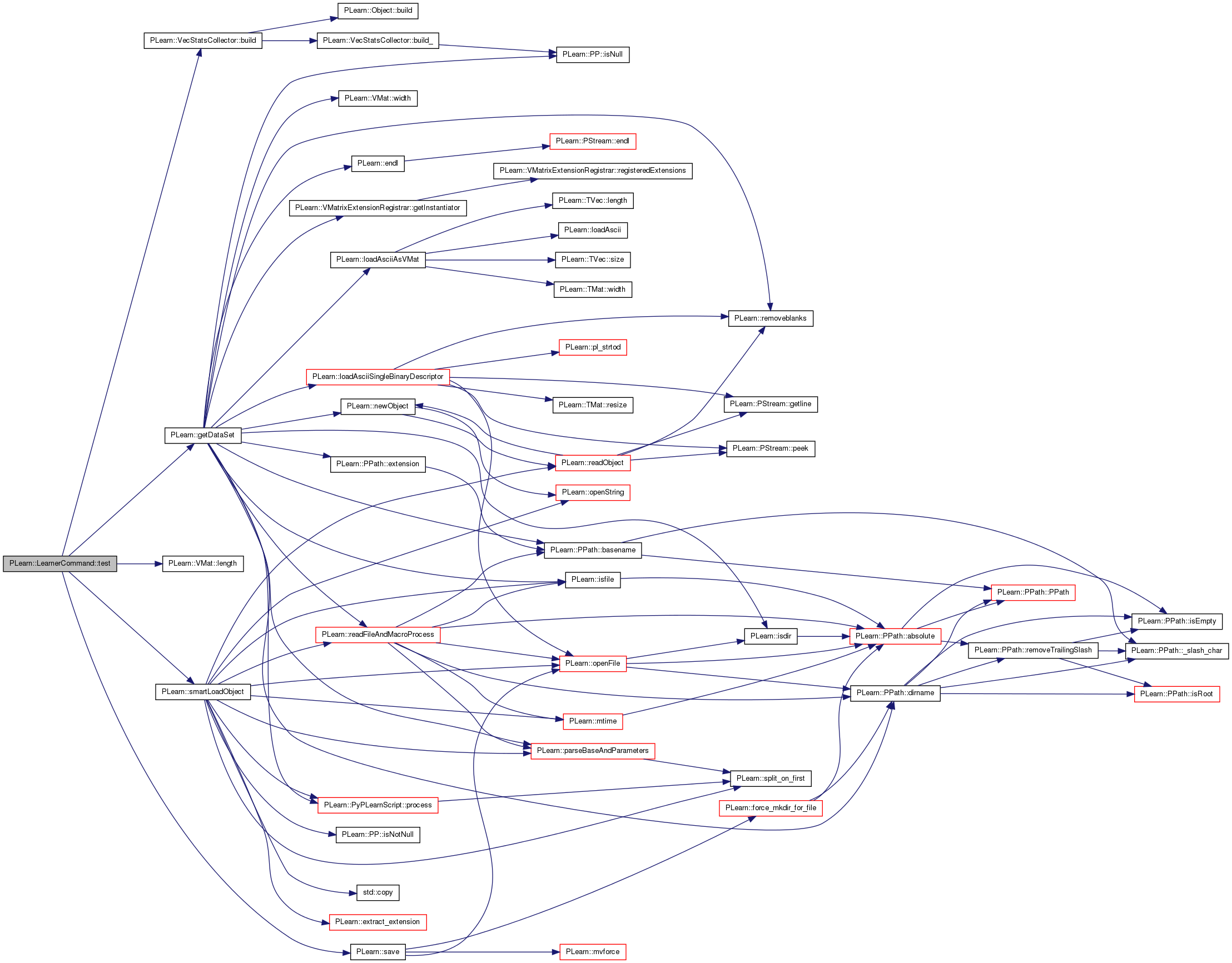

| void PLearn::LearnerCommand::train | ( | const PPath & | learner_spec_file, |
| const PPath & | trainset_spec, | ||
| const PPath & | save_learner_file, | ||
| bool | no_forget = false |
||
| ) | [static] |
Definition at line 108 of file LearnerCommand.cc.
References PLearn::PPath::absolute(), PLearn::getDataSet(), in, PLearn::openString(), PLearn::PStream::plearn_ascii, PLERROR, PLearn::readFileAndMacroProcess(), and PLearn::save().
Referenced by run().
{
PP<PLearner> learner;
string learner_spec = readFileAndMacroProcess(learner_spec_file);
PStream in = openString(learner_spec, PStream::plearn_ascii);
in >> learner;
if (learner.isNull())
PLERROR("This file cannot be correctly parsed (syntax error?): %s",
learner_spec_file.absolute().c_str());
VMat trainset = getDataSet(trainset_spec);
PP<VecStatsCollector> train_stats = new VecStatsCollector();
learner->setTrainStatsCollector(train_stats);
learner->setTrainingSet(trainset, !no_forget);
learner->train();
PLearn::save(save_learner_file, learner);
}
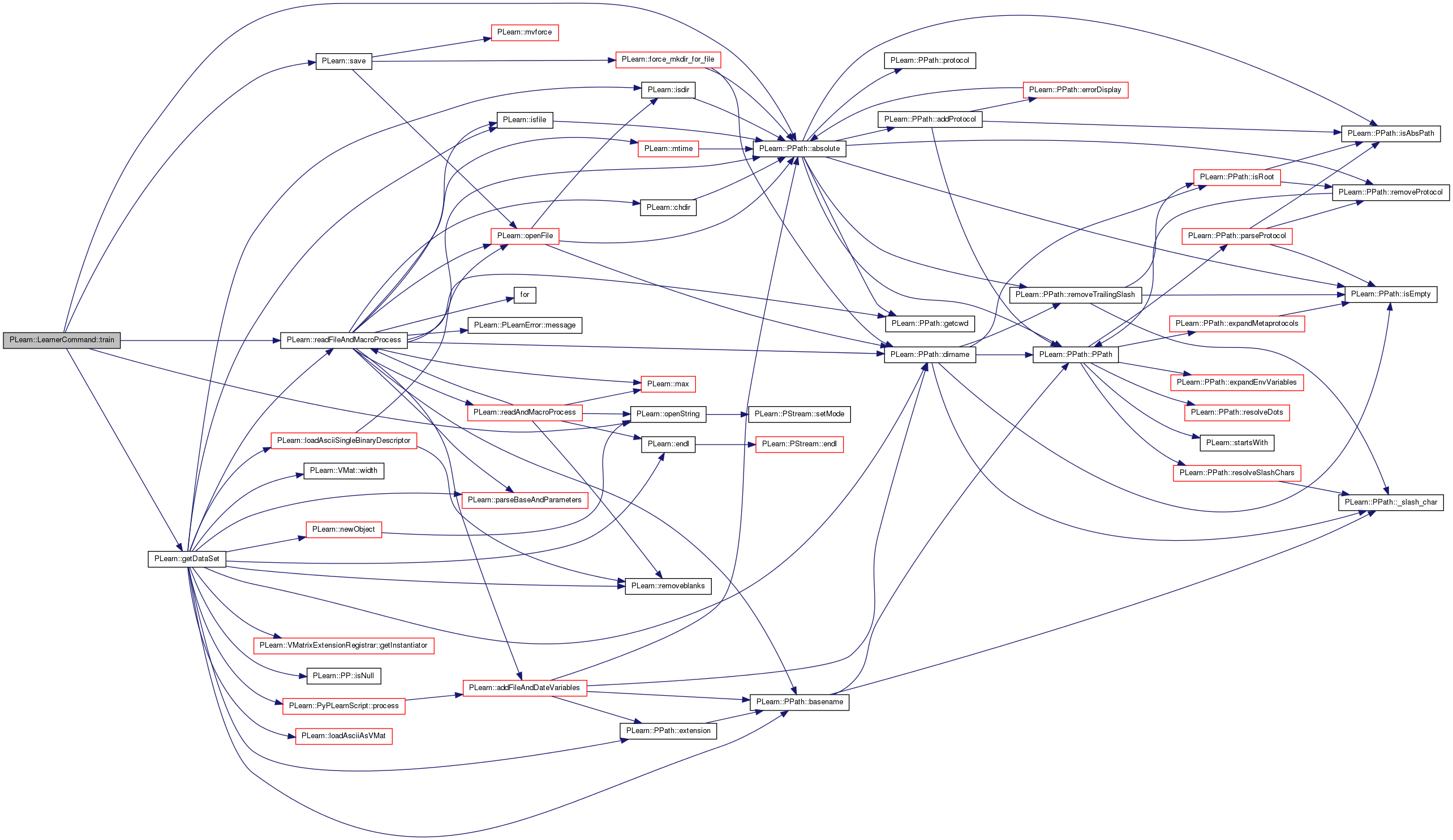

PLearnCommandRegistry PLearn::LearnerCommand::reg_ [static, protected] |
This allows to register the 'LearnerCommand' command in the command registry.
Definition at line 89 of file LearnerCommand.h.
 1.7.4
1.7.4